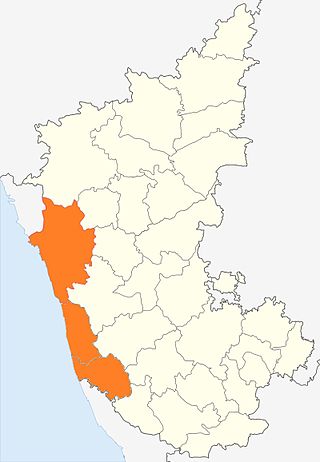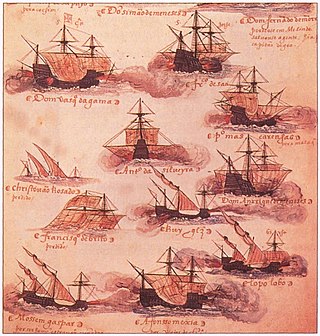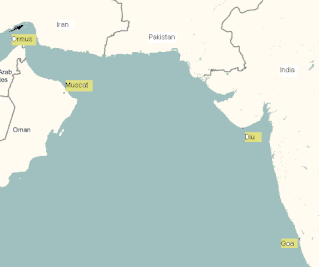Related Research Articles

Afonso de Albuquerque, 1st Duke of Goa, was a Portuguese general, admiral, and statesman. He served as viceroy of Portuguese India from 1509 to 1515, during which he expanded Portuguese influence across the Indian Ocean and built a reputation as a fierce and skilled military commander.

Tristão da Cunha was a Portuguese explorer and naval commander. In 1499, he served as ambassador from King Manuel I of Portugal to Pope Leo X, leading a luxurious embassy presenting in Rome the new conquests of Portugal. He later became a member of the Portuguese privy council.

The Portuguese Empire, also known as the Portuguese Overseas or the Portuguese Colonial Empire, was composed of the overseas colonies, factories, and later overseas territories, governed by the Kingdom of Portugal. It was one of the longest-lived colonial empires in European history, lasting almost six centuries from the conquest of Ceuta in North Africa in 1415, to the transfer of sovereignty over Macau to China in 1999. The empire began in the 15th century, and from the early 16th century it stretched across the globe, with bases in Africa, North America, South America, and various regions of Asia and Oceania.

The State of India, also referred as the Portuguese State of India or simply Portuguese India, was a state of the Portuguese Empire founded six years after the discovery of a sea route to the Indian subcontinent by Vasco da Gama, a subject of the Kingdom of Portugal. The capital of Portuguese India served as the governing centre of a string of military forts and trading posts scattered all over the Indian Ocean.

The Battle of Diu was a naval battle fought on 3 February 1509 in the Arabian Sea, in the port of Diu, India, between the Portuguese Empire and a joint fleet of the Sultan of Gujarat, the Mamlûk Burji Sultanate of Egypt and the Zamorin of Calicut.

Kanara or Canara, also known as Karavali is the historically significant stretch of land situated by the southwestern coast of India, alongside the Arabian Sea in the present-day Indian state of Karnataka. The subregion comprises three civil districts, namely: Uttara Kannada, Udupi, and Dakshina Kannada. Kassergode was included prior to the States Reorganisation Act.

The history of Goa dates back to prehistoric times, though the present-day state of Goa was only established as recently as 1987. In spite of being India's smallest state by area, Goa's history is both long and diverse. It shares a lot of similarities with Indian history, especially with regard to colonial influences and a multi-cultural aesthetic.

Dom Francisco de Almeida, also known as the Great Dom Francisco, was a Portuguese nobleman, soldier and explorer. He distinguished himself as a counsellor to King John II of Portugal and later in the wars against the Moors and in the conquest of Granada in 1492. In 1505 he was appointed as the first governor and viceroy of the Portuguese State of India. Almeida is credited with establishing Portuguese hegemony in the Indian Ocean with his victory at the naval Battle of Diu in 1509. Before Almeida returned to Portugal he lost his life in a conflict with indigenous people at the Cape of Good Hope in 1510. His only son Lourenço de Almeida had previously been killed in the Battle of Chaul.

Duarte Pacheco Pereira, called the Portuguese Achilles by the poet Camões, was a Portuguese sea captain, soldier, explorer and cartographer. He travelled particularly in the central Atlantic Ocean west of the Cape Verde islands, along the coast of West Africa and to India. His accomplishments in strategic warfare, exploration, mathematics and astronomy were of an exceptional level.

Ludovico di Varthema, also known as Barthema and Vertomannus, was an Italian traveller, diarist and aristocrat known for being one of the first non-Muslim Europeans to enter Mecca as a pilgrim. Nearly everything that is known about his life comes from his own account of his travels, Itinerario de Ludouico de Varthema Bolognese, published in Rome in 1510.
Bhatkal is a coastal town in the Uttara Kannada District of the Indian state of Karnataka. Bhatkal lies on National Highway 66, which runs between Mumbai and Kanyakumari, and has Bhatkal railway station which is one of the major railway stations along the Konkan Railway line, which runs between Mumbai and Mangalore.

Portuguese maritime exploration resulted in the numerous territories and maritime routes recorded by the Portuguese as a result of their intensive maritime journeys during the 15th and 16th centuries. Portuguese sailors were at the vanguard of European exploration, chronicling and mapping the coasts of Africa and Asia, then known as the East Indies, and Canada and Brazil, in what came to be known as the Age of Discovery.
Amir Husain Al-Kurdi,, named Mihir Hussain or Mir-Hocém or Mirocém by the Portuguese, was a Kurdish governor of the city of Jeddah in the Red Sea, then part of the Mamluk Sultanate, in early 16th century. He stood out as admiral of the Mamluk fleet fought by the forces of the Portuguese Empire in the Indian Ocean. Shortly after the arrival of the Portuguese to the Indian sea, Mirocem was sent by the last Mamluk Sultan, Al-Ashraf Qansuh al-Ghawri, to defend his interests in the sea, including the defense of the fleets of Muslim pilgrims to Mecca, then part of the sultanate.

Malik Ayyaz, called Meliqueaz by the Portuguese, was a naval officer and governor of the city of Diu, in the mouth of the Gulf of Khambhat (Cambay), circa 1507–1509 under the rule of Gujarat Sultanate. He was one of the most distinguished warriors of his time.

The Battle of Chaul was a naval battle between the Portuguese and an Egyptian Mamluk fleet in 1508 in the harbour of Chaul in India. The battle ended in a Mamluk victory. It followed the Siege of Cannanore in which a Portuguese garrison successfully resisted an attack by Southern Indian rulers. This was the first Portuguese defeat at sea in the Indian Ocean.

The Portuguese conquest of Goa occurred when the governor Afonso de Albuquerque captured the city in 1510 from the Adil Shahis. Old Goa became the capital of the Portuguese India which included territories such as Fort Manuel of Cochin, Bom Bahia, Damaon & Chaul. It was not among the places Albuquerque was supposed to conquer. He did so after he was offered the support and guidance of Timoji and his troops.

Egyptian Mamluk–Portuguese conflicts refers to the armed engagements between the Egyptian state of the Mamluks and the Portuguese in the Indian Ocean, following the expansion of the Portuguese after sailing around the Cape of Good Hope in 1498. The conflict took place during the early part of the 16th century, from 1505 to the fall of the Mamluk Sultanate in 1517.

The Goan Muslims are a minority community who follow Islam in the Indian coastal state of Goa, some are also present in the union territory of Damaon, Diu & Silvassa. They are native to Goa, unlike recent Muslim migrants from mainland India and are commonly referred to as Moir by Goans in Goan Konkani. Moir is derived from the Portuguese word Mouro. The Portuguese called them Mouros because they were in contact with the Moors, people of predominantly Muslim Maghreb country, who had conquered and colonised the Iberian peninsula for centuries.
The following lists events that happened during 1500 in India.

Adil Shahi–Portuguese conflicts refers to the various armed engagements that took place in India between the Portuguese Empire and the Sultanate of Bijapur, ruled by the Adil Shahi dynasty, whose rulers were known to the Portuguese as Hidalcão.
References
- ↑ Not to be mistaken for Timoji Nayak, a VOC's broker later, circa 1678, see
- ↑ The book of Duarte Barbosa By Duarte Barbosa, Fernão de Magalhães, Mansel Longworth Dames
- 1 2 3 Bhagamandala Seetharama Shastry, Charles J. Borges, "Goa-Kanara Portuguese relations, 1498-1763" p. 34-36
- ↑
- Kerr, Robert (1824). A General History and Collection of Voyages and Travels, Arranged in Systematic Order. Edinburgh: William Blackwood. (volume 6, I chapter)
- ↑ Foundations of the Portuguese Empire, 1415-1580, p. 253, Diffie, Winius 253, Diffie, Winius